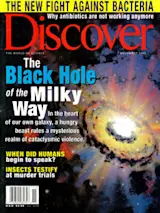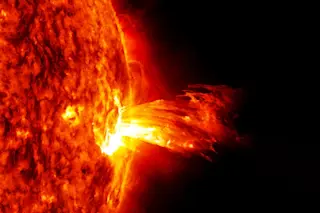Cosmic rays are high-energy particles that travel throughout the galaxy at velocities near the speed of light. Some hit our atmosphere, creating, among other things, radioactive carbon 14. Astrophysicists have long known that cosmic rays consist of electrons and protons and other particles but haven't had a precise idea about how they were created. Now a new theory holds that cosmic rays are born in the shock waves following the explosive deaths of massive stars.
When such a star explodes as a supernova, says astrophysicist Richard Lingenfelter of the University of California at San Diego, "the whole thing sort of blows its guts out," forming an enormous cloud of material that streams out at thousands of miles per second. The cloud consists of ionized gas, or plasma, and contains the elements hydrogen, helium, and oxygen, along with heavier elements that were generated during the blast itself.
As the cloud expands, ...














